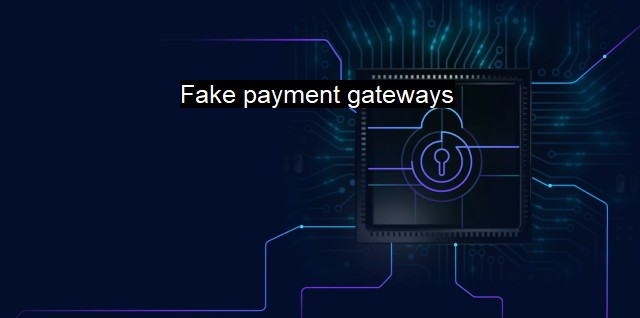What are Fake payment gateways?
Combatting Cyber Threats: The Impact of Fake Payment Gateways on Online Transactions and The Role of Antivirus Software in Ensuring Cybersecurity
In the current digital era with increasing reliance on internet technology, cybersecurity has progressed exceptionally from a mere concept to an absolute necessity. Among the most exploited areas for perpetuating cyber fraud, one striking domain is the payment gateway infrastructure. "Fake payment gateways" are fabricated systems formed by cybercriminals, impersonating legitimate payment portals, intended to deceitfully gather individuals' confidential monetary information.The concepts of "fake payment gateways" vaguely cling to the idea of phishing scams, which aim at filching sensitive data including credit card details, bank account credentials, and social security numbers. Lured by the perception of a legitimate transaction, victims unknowingly bequeath their pertinent data to these fraudulent portals. The scammers then exploit this data to siphon money from the victims' accounts or ill-use their credit card information, leading to financial loss as well as identity theft.
The complex manner by which these fake payment gateways are incorporated into popular e-commerce websites or highlighted through influential email campaigns makes them more precarious and irresistible. Cyber adversaries often exploit website vulnerabilities or use sophistic methods of injecting malicious codes into the transaction pages of websites to trick consumers into entering their details in the cloned pages.
These rogue payment gateways demonstrate a high standard of anatomical accuracy about the original gateways to mislead even cautious users. High-quality clones can even mirror animations, logos, color patterns, and page layouts to an extent where distinguishing the spurious from the genuine becomes onerously arduous. In certain cases, the URLs are manipulated to mirror legitimate domains, misleading users into thinking they are on the authentic page.
The rise of fake payment gateways and their astoundingly successful attempts to extract sensitive customer data underscores an urgent need for efficient antivirus software and comprehensive cybersecurity frameworks. Antivirus tools can help by detecting and fending off malicious software trying to infringe users’ privacy, simultaneously alerting the owner about the potential threats.
Zero-day threats, constantly evolving malware strains, and sophisticated phishing mechanisms circumvent conventional antivirus approaches, necessitating smarter solutions. The context then shifts to behavioral analysis where the software bodes ill when noticing anomalous actions indicating fraudulent activities, even if the malicious code had already bypassed the initial screening.
As businesses and consumers bolster their cyber defenses, scammers are refining their methods furiously. Cybersecurity cannot remain just responsive anymore and has to assume a preemptive stance. It involves being sufficiently informed about current popular scams, understanding how fake payment gateways operate, the typical indicators of a fraudulent portal like incorrectly spelled URLs or lack of HTTPS, and the significance of secured online transactions.
The cooperation of companies and banking institutions is another crucial aspect of countering fraudulent payment gateways. Collaboration between the corporate fraternity and cybersecurity firms can lead to imposing security standards, achievable through shared threat intelligence, robust security protocols, and mutual validation practices.
Grasping the essence of 'Fake payment gateways' underlines the rightful sense of fear and provides reinforcement towards expanding modern cybersecurity and antivirus mechanisms. Although the onset of fraud can never truly be eradicated, understanding the mechanics of these cyberattacks can facilitate decision-making geared towards effective defenses.
The subject of fake payment gateways steers the overarching discussion about cybersecurity from a reactive battlefield perspective to a theater of intelligence. This intelligence has to be imbued right from the user level, where each person recognizes and combats the ill-effects of cybercrimes like fake payment gateways, only then, a sustainable victory over cybercrime is foreseeable. The current cyber landscape validates the somber requirement for an efficient cybersecurity framework and virus detection in preventing ourselves from falling prey to such deceits.

Fake payment gateways FAQs
What are fake payment gateways?
Fake payment gateways are fraudulent websites or mobile apps that mimic legitimate payment gateways to steal sensitive information such as credit card numbers or login credentials. This type of scam is a common tactic used by cybercriminals to trick unsuspecting victims into giving up their personal information.How can I identify a fake payment gateway?
One way to identify a fake payment gateway is by checking the URL of the website or mobile app. Legitimate payment gateways often use HTTPS instead of HTTP, which means the connection is secure. You can also verify that the payment gateway is legitimate by checking their credentials and reviews.What should I do if I encounter a fake payment gateway?
If you encounter a fake payment gateway, do not enter any personal or financial information. Close the website or app immediately and report it to the authorities. You should also run a full virus scan on your device to ensure that your system has not been compromised.How can I protect myself from fake payment gateways?
To protect yourself from fake payment gateways, always use reputable and trusted payment gateways. Avoid clicking on suspicious links or downloading apps from untrusted sources. Also, make sure to keep your antivirus software up-to-date and perform regular scans on your devices. If you suspect that your personal information has been compromised, contact your financial institution immediately.| | A | | | B | | | C | | | D | | | E | | | F | | | G | | | H | | | I | | | J | | | K | | | L | | | M | |
| | N | | | O | | | P | | | Q | | | R | | | S | | | T | | | U | | | V | | | W | | | X | | | Y | | | Z | |
| | 1 | | | 2 | | | 3 | | | 4 | | | 7 | | | 8 | | |||||||